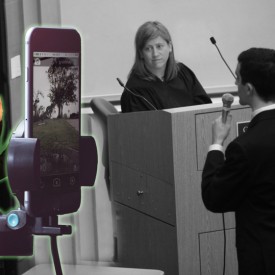 Are IME and Peer-Review Doctors Accountable in the Doctor-Patient Relationship?
Are IME and Peer-Review Doctors Accountable in the Doctor-Patient Relationship?
By Mark Studin, DC, FASBE(C), DAAPM, DAAMLP
Read original article from Dynamic Chiropractic here
An independent medical examination (IME) is performed by a doctor who has not previously been involved in the treatment of a given patient. By definition, the IME doctor renders a second opinion that allows for necessary care of covered issues of injured patients.
The purpose is to either protect the payer from overutilization or to certify that an employee is fit for the task they were hired to do. While there are many arguments about the integrity of the process, let’s explore the relationship the IME and peer-review doctors have with patients, and the licensure and liability issues those doctors face when reporting partial facts and/or clinically incorrect diagnoses and conclusions.
As the sampling of cases below shows, each state takes it own approach and reaches different conclusions. However, when a court rules on this issue, it often affects every medical professional practicing in that state, from chiropractic to dentistry to medicine to podiatry. Therefore, it is critical to understand your jurisdiction’s law and pay attention to all of the decisions issued by courts in each state in which you practice (regardless of your specific practice specialty) to determine the legal obligation of doctors to their patients and your liability.
(Note: The endnotes are the core of this article, as they explain in legal terms the “duty of care” every doctor is held to specific to the state referenced.)
Beyond licensure issues, various courts (hearing lawsuits for malpractice and other causes of action) have ruled on this same issue. Courts in many states, such as Alaska, Missouri and Colorado, have ruled that IME doctors do not have doctor-patient relationships and therefore, have no legal “duty of care” toward the patient being examined. These states and others have “tied the hands” of their respective state licensure boards, which cannot protect the residents of their states. They are unable to hold these doctors to current standards for failing to either complete competent examinations or report the truth.
While an “independent and peer-review examination” comes in many forms, from pre-employment to record review or at the request of an insurer or other third-party payer, courts both at the state and federal levels have a dichotomy in opinion. Either the court feels that the reviewing doctor is responsible for their actions in the doctor-patient encounter, no matter how limited, or it does not. Regardless of how a state rules, the undeniable fact remains that the health and welfare of the people of all 50 states and U.S. territories are at stake, as the public relies on doctors who have historically been held to a higher standard.
Typical language written by IME doctors is exemplified by an orthopedic surgeon in New York, who wrote the following: “The above captioned claimant is examined in accordance with the restrictive rules concerning an independent medical evaluation. Prior to the evaluation, it was explained to the examinee that this appointment was for the purpose of evaluation only and not for care, treatment or consultation, and therefore, no doctor-patient relationship would result.” The purpose of this language is to attempt to establish that the IME doctor is not held to the same standards as a treating doctor, thereby insulating the doctor from any licensure or malpractice issues based upon any conclusion and giving them more leeway in rendering an opinion.
However, in Kirschner v Mills, a mid-level appeals court in New York State ruled that it did notinsulate the doctor. The claimant was referred to an independent medical examiner by the insurance company because the IME was a practicing doctor and his conclusions were intended to influence treatment authorization decisions by the referring companies. As a result, the court ruled that this type of professional activity falls within the jurisdiction of the New York State Department of Education and the doctor must be held to the same standard as any treating doctor. Therefore, this doctor was subject to professional misconduct proceedings for such “non-treating” acts as giving false testimony as a medical expert. Please refer to endnote #1 for the pertinent language of this ruling.
In Smith v Radecki, a workers’ compensation IME doctor diagnosed an IME patient with mild degeneration and minimal asymptomatic disc bulging and called the pain “psychogenic,” denying the patient any form of disability or future care. The Supreme Court of Alaska held that although the IME doctor was allegedly aware of the patient’s failed back surgery and significant perineural (symptomatic) cysts along with disc desiccation at three lumbar levels and displacement of the nerve roots at L5 and S1, he didn’t report any of the above to either the patient or in his report. Yet the IME doctor had no “duty of care” to the patient.
In short, despite allegedly withholding significant information to reach a desired outcome for those who hired him, the Alaska courts allow these doctors to perpetrate apparent license violations without consequences under the umbrella of limited doctor-patient relationships holding no “duty of care.”2
In Joseph v District of Columbia Bd. of Medicine, the District of Columbia Court of Appeals reported that a medical doctor had willfully made or filed a false report in the practice of a health occupation as an expert witness and as a non-treating hired expert. The courts ruled that nothing in the statute limits discipline for fraudulent diagnoses to cases in which the fraud is perpetrated directly on the patient.
The court went on the explain that although this doctor was hired by an “independent forensiccompany,” the insurance companies frequently are the ultimate payors of the medical bills in personal-injury cases and they, too, are entitled to true medical reports. The court concluded that it makes no difference whether false reports are submitted directly to the patient, attorney or the insurance company on behalf of the patient. The statute authorizes discipline in any event and calls the doctor’s actions a fraudulent scheme that was dependent upon the misuse of his medical license. Please refer to endnote #2 for the pertinent language of this ruling.3
At issue in Ritchie v Krasner, an Arizona case, was the following disclaimer the IME doctor wrote in his report: “It is very important that you realize that no Doctor/Patient relationship exists between you and [the IME doctor]. Because of this, the results of this evaluation will not be given to you or to anyone that you may request to receive them. This is done to [ensure] that all findings will be neutral, and that the evaluators are completely independent and not involved in your disability claim or source.”4
A mid-level Arizona appellate court concluded that this IME doctor failed to diagnose a spinal cord compression (the patient eventually died). The surviving family sought to establish that the IME doctor’s negligence increased the risk of injury or death. The court ruled that a formal doctor-patient relationship need not exist for a duty of reasonable care to arise. The court did not read the agreement as eliminating the IME doctor’s duty to do his job in a reasonable manner. Please refer to endnote #3 for the pertinent language of this ruling.
In Arizona, a different court ruled in Hafner v Beck that the independent medical examiner held no duty of care in an opposing ruling in the same state. This underscores that although one court renders a ruling, unless it is upheld in the Court of Appeals as the law of the state, a lower- or mid-level court may oppose decisions based upon the merits of the case.5
In a Michigan case, Dyer v Trachtman, an IME doctor caused bodily injury to the left knee and right shoulder of a patient while conducting an examination. The Supreme Court of Michigan allowed a claim of negligence against the examining IME doctor, holding that an examining doctor, albeit in a limited “duty of care,” has the responsibility not to cause physical harm.
Michigan still does not hold the doctor responsible in malpractice claims for their opinions should they lead to harm, but holds the doctor liable for their actions when caring for a patient. In addition, the Supreme Court of Michigan ruled that this cannot be considered a malpractice claim because there is no true doctor-patient relationship, thereby leaving IME and peer-review doctors exposed to civil litigation should a patient get injured during the examination with potentially no insurance coverage.
The exposure to litigation without coverage makes Michigan a very difficult state within which to perform IMEs and peer reviews, as the reason for performing the IMEs is purely financial, yet those doctors are exposed to losing far more than they can earn, perhaps in a lifetime.6 Please refer to endnote #4 for the pertinent language of this ruling.






 March 18
March 18








